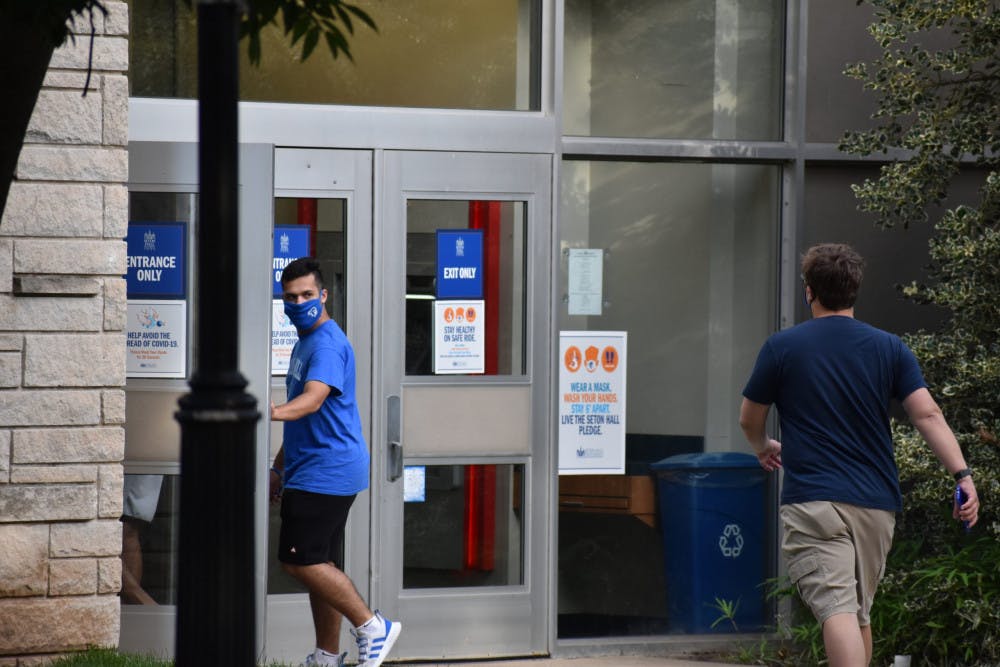Seton Hall recorded four new cases of the coronavirus on Wednesday evening, its highest single-day increase. According to the Health Intervention and Communication Team (HICT) dashboard, three of the cases appear to be related to another confirmed case from Oct. 20 – another first for the University which, until this point, had only reported isolated cases.
The new numbers now bring the University to 17 coronavirus cases since the start of the semester for a total of 24 cases since the pandemic began in March.
The cases were detected through the University’s testing protocol on Wednesday. Three of the students were reported as having lived off campus, while the fourth lived in on-campus housing and is now quarantining in Ora Manor. The University made no mention of the quarantine protocols for the other three students nor did it mention the estimated risk of exposure to other sectors of campus.
Since the start of October, Seton Hall has reported 10 cases of the coronavirus alone, more than doubling September’s total case count. The month of October now accounts for 42% of the total coronavirus cases the University has seen since March.
The cases come amid a broader trend of community transmission of the virus in New Jersey, which experienced a summertime lull in cases while the country as a whole saw record numbers of infections.
On Wednesday, New Jersey reported 1,062 new cases of the coronavirus, the fourth straight day that cases surged past 1,000. That same day, Gov. Phil Murphy was abruptly pulled from an event at Camden County Community College after it was revealed he had come into contact with a staffer on Saturday who has since tested positive.
According to a statement from Murphy’s office, the Governor and First Lady Tammy Murphy both tested negative on Wednesday afternoon for COVID-19.
Other universities in the state have also seen upticks in cases, like Monmouth University in Ocean County which recorded as many as 193 active cases at its peak on Oct. 6.
According to a statement from Monmouth University President Dr. Patrick Leahy, an “overwhelming majority” of the cases at that time could be traced back to an off-campus event hosted two weeks prior, which Leahy classified as a “superspreader event.”
On Oct. 14, Fairleigh-Dickinson University reported five additional cases of the virus on its Metropolitan Campus in Teaneck, which the University said stemmed “from an off-campus party,” as well, that was held the weekend prior. In the most recent update on Tuesday, the School only reported two additional cases since.
Right now, it is unclear what the relationship is between the four students whose cases Seton Hall has identified as being “related,” nor is it clear if these cases stem from any broader event.
Recently, state health officials have been warning of accelerated community spread in New Jersey that was being facilitated in part by informal house parties and gatherings, predominantly among young adults.
On Oct. 8, State Commissioner of Health Judith Persichilli reported “increasing signs of community spread” predominantly among adolescents and young adults who are attending the aforementioned parties and gatherings, and said that the state was anticipating a “second wave” of the virus.
Just days later on Oct. 12, South Orange reported its worst day for daily coronavirus cases since April, with five new cases of the virus.
That same day, South Orange Village President Sheena Collum noted at a Board of Trustees meeting that the town had been made aware of “large house parties” among Columbia High School students and said that a 17-year-old female, as well as another student identified by the South Orange-Maplewood School district, was one of the five new positives.
Five days later on Oct. 17, The Village Green reported that an additional four teenage residents had tested positive for the virus, bringing the total to six.
Public health officials have long warned of a potential second wave of the coronavirus during the fall and winter months, when respiratory infections are known to spread through the cold air easier and when more and more individuals begin spending increased time indoors, where the risk of viral spread is thought to be higher.
Seton Hall noted these risks in a Sept. 24 email from HICT co-chairs Dr. Shawna Cooper-Gibson and Matthew Borowick (’89) which announced that the University would begin random surveillance testing 5% of its resident student population each week, citing an increase in national case numbers, colder weather and a heightened level of indoor activity. In the weeks since the announcement, the University has tested over 800 students, according to a Setonian analysis of HICT dashboard data.
Nicholas Kerr can be reached at nicholas.kerr@student.shu.edu. Find him on Twitter @nickdotkerr.





